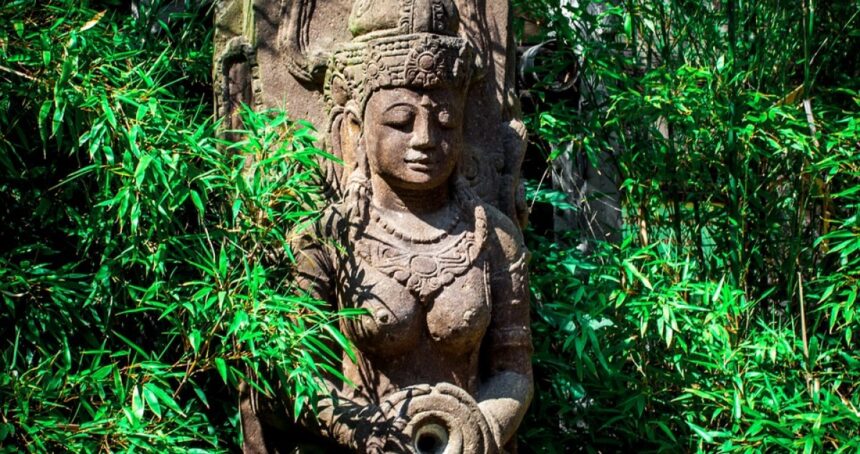Bharatvarsha's spiritual link with nature has formed the basis of its belief, which sadly even in such an exploitative world has come under the scanner.
India’s own sacred ecology

The creation of a sacred geography for India was always a major instrument of her cultural integration. Not only the countless teerthas, but also the mountains, seas, rivers, forests, trees and other plants, animals big and small, were imbued with divinity. Of course, most pre-Judeo-Christian cultures shared this worldview: from the Nile to Mount Olympus, from Yggdrasil, the cosmic tree of Norse mythology, to the phoenix, that universe was crowded with living symbols drawn from nature. The notion of a creator apart from his creation, superior to it, more often cursing than loving it, is a wedge that Judaism and its two daughter religions vertically drove into a hitherto seamless cosmos.
In the Rig Veda, India’s earliest text, earth and heaven are addressed as a single being (dyavaprithivi); they are “father and mother” but also the “twins”; together, they “keep all creatures safe”. India’s Yggdrasil is the ashvattha(the pipal or Boddhi tree) which the Gita turned upside down: the cosmic tree, the origin of India’s tree-worshipping traditions, has its roots above and branches below — a transparent symbol for this creation, which can be represented by a cosmic cow, the source of all food. Indeed symbols endlessly multiply, from celestial rivers to the gods’ vahanas. More importantly, the Upanishadic precept that “all creatures are impelled by consciousness” unites us to the humblest plant or animal.
Is this the origin of the Buddhist and Jain doctrine of ahimsa or the concept of wildlife sanctuary in Ashoka’s edicts as in Kautilya’s Arthashastra, perhaps a “world first”? If so, this tradition is more than just idyllic. Not everyone agrees. Meera Nanda, for instance, a selfstyled historian of science whom I had occasion to critique in earlier articles, condemns this “Dharmic ecology”, which she defines as “an unabashedly Hindu supremacist, nationalistic version of the same religious environmentalism that the anti-Enlightenment left has been preaching and practicing.”
Nanda sees this worldview as a dangerous weapon in Hindutva’s arsenal:
“Dharmic ecology of Hindutva right is emerging as the hub of a new neo-pagan International. Neopaganism in Europe and America has deep and historic ties with Nazi and Neo-Nazi groups,”
and, as we know, there is a “long history of the Nazi and neo-Nazi involvement with occult and paganism.” Thus the syllogism works as follows: Indic traditions of sacred ecology (as I prefer to call it) are pagan; Nazism was involved with paganism; the said Indic traditions are thus obscurantist and dangerous.
The fallacy of it is glaring: the premise is incorrect; Hindu beliefs behind sacred ecology are not just “pagan”, a term of contempt created by medieval Christianity; they are founded on a philosophy and a spiritual experience of the “nature of nature”. And the association with Nazism is a vicious case of reductio ad Hitlerism. (to put it crudely: if you wear boots, you may be accused of a link with Nazism, since Hitler wore boots too). It has indeed become a fashion among certain intellectuals to “reveal” hidden connections between Hinduism and Nazism. Nanda’s more serious criticism is that there is no evidence that India’s sacred ecology “encourages wise use of nature”.
Instead, she advocates “secular environmentalism” as a “source of secularism and a class-based collective action”. It may be true that today’s Indians have by and large poor environmental awareness, wantonly contributing to the destruction of forests, the disappearance of wildlife and the spiralling pollution. But perhaps that is because Indian society has hardly had any transition between tradition and modernity. From the rich ethno-botanical traditions of the Bishnois, Bhils, Warlis, Santhals or Todas to the current urbanite disaster, there has been almost no time to adapt.
In fact, modern India’s dogma has been to erect science and technology as an exclusive and all-knowing godhead, instead of fusing it with proven conservation techniques, from sacred groves to decentralised and highly effective water structures. As regards the global scene, the last century did see movements promoting some kind of “secular environmentalism” and contributing much to the current awakening. But other movements have tried to move on to a “spiritual” view of nature, inspired by a wide range of perspectives from Thoreau’s Walden to Rudolf Steiner to the British biochemist James Lovelock’s well-known Gaia theory, in which the earth is seen as a conscious superorganism — not unlike (for its philosophical aspect alone) the ancient Indian view of the planet as Bhu or Prithvi.
Since then, environmental thinkers, such as Arne Naess, Henryk Skolimowski, David Suzuki and many more, have called for a “deep ecology”, “ecosophy”, “spiritual ecology” or “spiritual environmentalism”. As Suzuki puts it,
“The way we see the world shapes the way we treat it. If a mountain is a deity, not a pile of ore; if a river is one of the veins of the land, not irrigation water; if a forest is a sacred grove, not timber; if other species are biological kin, not resources; or if the planet is our mother, not an opportunity—then we will treat each other with greater respect. Thus is the challenge, to look at the world from a different perspective.” There can hardly be a better summary of India’s own sacred ecology. As the Atharva Veda prayed, “Upon the immutable, vast earth supported by the law, the universal mother of the plants, peaceful and kind, may we walk forever!”

Leave a Reply